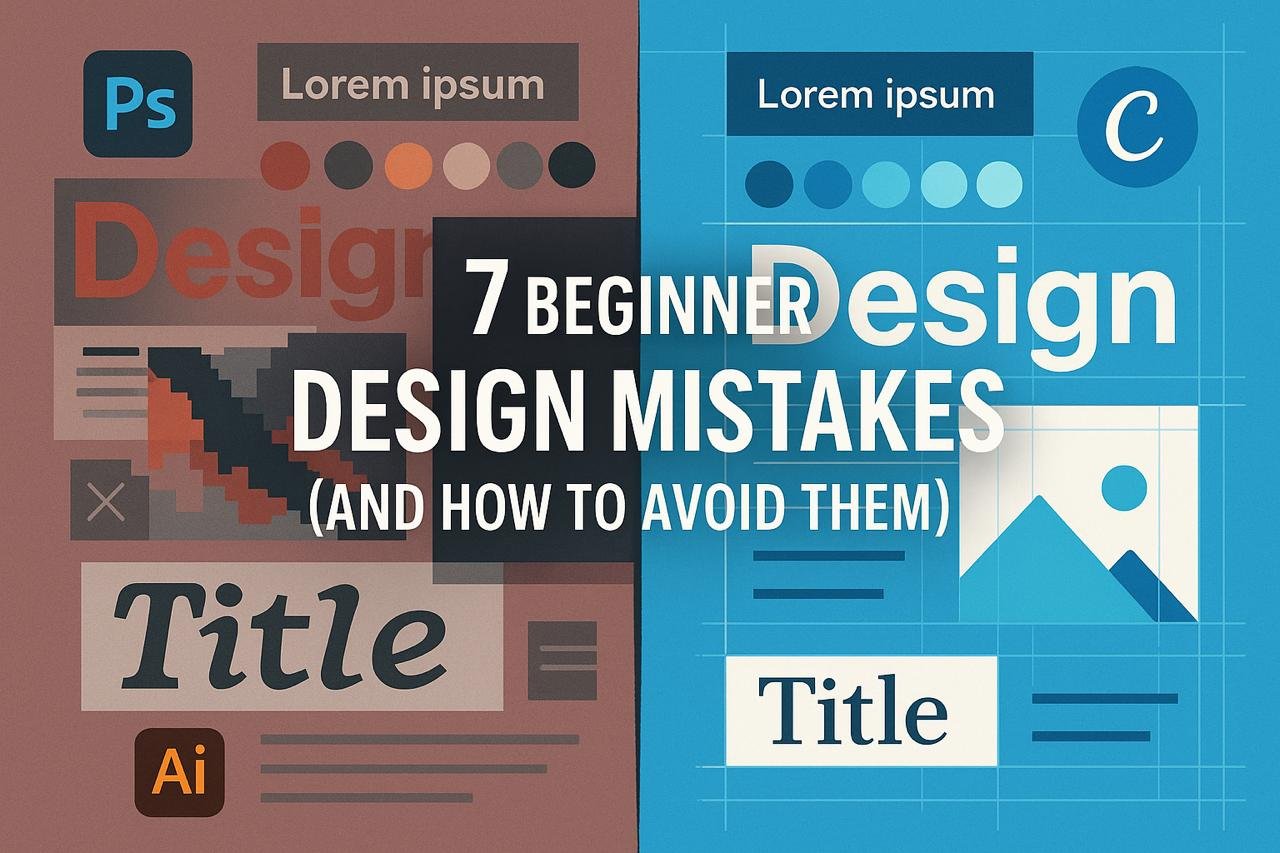7 Mistakes Beginner Designers Make (and How to Avoid Them)

Starting your journey as a graphic designer can be exciting — every project feels like an opportunity to express creativity. But beginners often make mistakes that slow down their progress, limit their career growth, or result in designs that don't meet professional standards.
Here's the good news: most of these mistakes are easy to avoid once you know what they are. By learning from the experience of industry professionals, you can save time, improve your skills faster, and build a portfolio that actually gets you hired.
In this article, we'll uncover 7 common mistakes beginner designers make — and simple, practical tips to avoid them.
Ignoring the Basics of Design Principles
The Mistake:
Many beginners jump straight into Photoshop, Illustrator, or Canva tutorials without first learning the fundamentals of design.
Why It's a Problem:
Design principles like alignment, contrast, hierarchy, white space, and balance are what separate amateur work from professional designs. Without them, your visuals may feel cluttered or confusing.
How to Avoid It:
- • Learn the rules of design first before breaking them
- • Practice with small projects — redesign a poster, flyer, or Instagram ad while focusing on balance and hierarchy
- • Follow resources/books like "The Non-Designer's Design Book"
At RedSketch Academy's Digital Graphic Design Course, we teach principles hands-on with real projects so they become second nature.
Using Too Many Fonts and Colors
The Mistake:
Beginners often get excited with endless options, using five fonts or ten colors in a single design.
Why It's a Problem:
Instead of looking creative, the design feels chaotic and unprofessional. Brands value consistency, not confusion.
How to Avoid It:
Great design is not about "more" — it's about clarity and harmony.
Overusing Effects and Filters
The Mistake:
Adding too many shadows, glows, gradients, or filters to make designs "stand out."
Why It's a Problem:
Overdone effects scream beginner work. Instead of enhancing the message, they distract from it.
How to Avoid It:
- • Use effects subtly and with intention
- • Study minimalist and flat design trends to see how simplicity often wins
- • Ask: Does this effect add value to the design's purpose? If not, remove it
A clean design with strong typography will always beat an overloaded, "gimmicky" one.
Poor Attention to Alignment and Spacing
The Mistake:
Text is slightly off-center. Icons aren't evenly spaced. Images don't align to the grid.
Why It's a Problem:
Bad alignment makes even great ideas look sloppy. It signals carelessness and creates poor readability.
How to Avoid It:
- • Always use grids and guides (available in Photoshop, Illustrator, Canva, Figma)
- • Practice "pixel-perfect" design by zooming in and checking alignment
- • Apply consistent margins and padding across all elements
Alignment and spacing are invisible rules that make designs feel professional and polished.
Forgetting the Target Audience
The Mistake:
Designing for yourself instead of the end user or client.
Why It's a Problem:
The purpose of design is communication — not just personal expression. A design that looks great to you may not connect with the audience.
How to Avoid It:
- • Start every project with a creative brief: Who is this for? What message should it deliver?
- • Research audience demographics (age, culture, interests) before designing
- • Test your design with peers or small focus groups for feedback
Professional designers combine creativity with empathy — understanding what the audience wants to see.
Weak File Organization and Delivery
The Mistake:
Beginners often name files randomly (like "final_final_v3.png") or deliver flattened, low-res images.
Why It's a Problem:
Unorganized files waste time, confuse clients, and make collaboration difficult.
How to Avoid It:
File discipline builds your professional reputation faster than design alone.
Neglecting Feedback and Continuous Learning
The Mistake:
Beginners often take criticism personally, or worse — avoid seeking feedback at all.
Why It's a Problem:
Design is subjective, but improvement requires constructive critique. Without feedback, your growth slows down.
How to Avoid It:
- • Share your work on platforms like Behance, Dribbble, or design communities
- • Treat criticism as free coaching
- • Follow top design blogs, YouTube tutorials, and keep upgrading skills through structured courses
The best designers are lifelong learners — they evolve with trends, tools, and technology.
Common Bonus Mistake: Not Building a Portfolio Early
Many beginners wait until they're "good enough" before making a portfolio. This delays opportunities.
Even small practice projects can go into your portfolio to show your growth.
Frequently Asked Questions
Q1. What's the biggest mistake new designers make?
👉 Ignoring design principles and jumping into software without understanding the basics.
Q2. Should I use Canva or Photoshop as a beginner?
👉 Both! Canva is great for quick social designs, while Photoshop offers professional control. Learn both for flexibility.
Q3. How do I avoid looking like an amateur?
👉 Focus on simplicity, alignment, and consistency. Avoid too many fonts/effects.
Q4. What's the fastest way to improve as a designer?
👉 Practice daily, study professional designs, and get feedback from mentors or courses.
Conclusion
Mistakes are part of learning — but by being aware of these 7 common beginner design pitfalls, you can avoid wasting time and accelerate your growth.
Remember: great design is not just about flashy visuals. It's about clarity, balance, and communication. With consistent practice, constructive feedback, and strong fundamentals, you'll soon create designs that look professional and job-ready.
At RedSketch Academy, our Digital Graphic Design Course helps beginners skip these common mistakes by teaching fundamentals + advanced tools + real-world projects. With 100% job guarantee and lifetime support, you don't just learn design — you build a career.
Turn Your Passion Into Professional Skills
Ready to avoid beginner mistakes and design like a pro? Join RedSketch's flagship programs in Graphic Design, Video Editing, Animation, and Marketing — and start creating professional-quality work from day one.